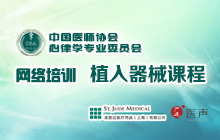对慢性心衰患者应用植入式肺动脉压监测设备的成本效益分析
2016-09-22 14:45
研究目的:研究的目标为评估CardioMEMES(CardioMEMES心衰监测系统,圣犹达公司,亚特兰大,乔治亚州)设备应用于慢性心衰患者中的成本效益。
阅读数: 1171
研究背景:CardioMEMS是一种植入式的肺动脉压监测设备,已经在CHAMPION(CardioMEMS心脏压力监测传感器改善NYHA III级心衰患者临床疗效)研究中证实了可以减少心衰住院率和提高患者的生活质量。
研究方法:我们建立了一个马尔科夫统计学模型来确定在CHAMPION研究中CardioMEMS植入组与常规治疗组在心衰人群住院率、生存率、生活质量、费用、以及增量成本-效益比的数据。我们通过公开发表的研究数据取得了事件发生率及流程;我们通过文献调研和医疗保险账务数据取得了费用开支。我们对射血分数保持与下降的患者进行亚组分析,同时探索性的对CHARM(坎地沙坦在心衰中的应用:减少死亡率与发病率)研究中的低风险人群进行分析。
研究结果:CardioMEMS减少生存期间住院风险(2.18 vs 3.12),增加质量调整生命年(QALYs)(2.74 vs. 2.46),增加经济开销($176,648 vs. $156,569),由此每个质量调整生命年产生$71,462的费用,每个自然生命年产生$48,054的费用。在射血分数下降的患者中,每个质量调整生命年的费用产生是$82,301,在射血分数保留的患者中,每个质量调整生命年的费用是$47,768。在CHARM研究中的低风险人群中,CardioMEMS可以降低41%的心衰住院,使得每个质量调整生命年的费用小于$100,000。成本效益对设备持续使用的时间有最高的灵敏度。
研究结论
在与CHAMPION研究类似的人群中,当试验效力持续较长的时间时,CardioMEMS装置可获得好的成本效益。上市后持续的监督数据将提供更多更有力的证实该技术的价值。
OBJECTIVES This study aimed to evaluate the cost-effectiveness of the CardioMEMS (CardioMEMS Heart Failure System, St Jude Medical Inc, Atlanta, Georgia) device in patients with chronic heart failure.
BACKGROUND The CardioMEMS device, an implantable pulmonary artery pressure monitor, was shown to reduce hospitalizations for heart failure and improve quality of life in the CHAMPION (CardioMEMS Heart Sensor Allows Monitoring of Pressure to Improve Outcomes in NYHA Class III Heart Failure Patients) trial.
METHODS We developed a Markov model to determine the hospitalization, survival, quality of life, cost, and incre- mental cost-effectiveness ratio of CardioMEMS implantation compared with usual care among a CHAMPION trial cohort of patients with heart failure. We obtained event rates and utilities from published trial data; we used costs from liter- ature estimates and Medicare reimbursement data. We performed subgroup analyses of preserved and reduced ejection fraction and an exploratory analysis in a lower-risk cohort on the basis of the CHARM (Candesartan in Heart failure: Reduction in Mortality and Morbidity) trials.
RESULTS CardioMEMS reduced lifetime hospitalizations (2.18 vs. 3.12), increased quality-adjusted life-years (QALYs) (2.74 vs. 2.46), and increased costs ($176,648 vs. $156,569), thus yielding a cost of $71,462 per QALY gained and $48,054 per life-year gained. The cost per QALY gained was $82,301 in patients with reduced ejection fraction and $47,768 in those with preserved ejection fraction. In the lower-risk CHARM cohort, the device would need to reduce hospitalizations for heart failure by 41% to cost <$100,000 per QALY gained. The cost-effectiveness was most sensitive to the device’s durability.
CONCLUSIONS In populations similar to that of the CHAMPION trial, the CardioMEMS device is cost-effective if the trial effectiveness is sustained over long periods. Post-marketing surveillance data on durability will further clarify its value.
(J Am Coll Cardiol HF 2016;4:368–75) © 2016 by the American College of Cardiology Foundation.
